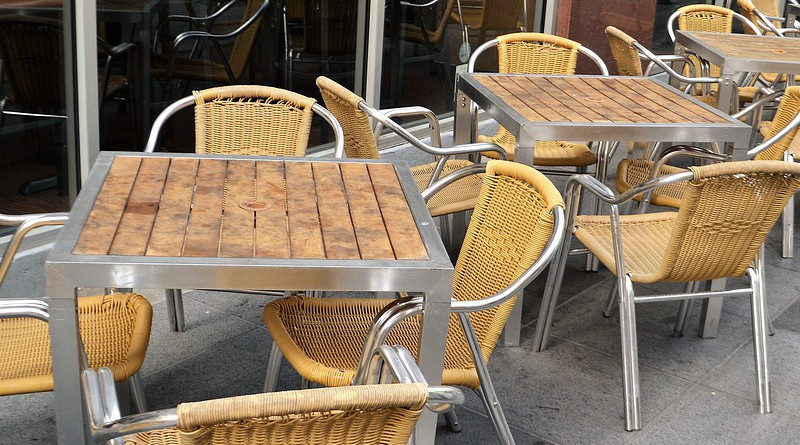Restaurants Face ‘Wave Of Bankruptcies’ After Lockdowns
By EurActiv
By Dave Keating
(EurActiv) — The food services sector has been hit hard by the Coronavirus pandemic, but governments are struggling to find ways to reopen safely.
On Monday, Italy eased restrictions in sixteen regions, allowing restaurants and museums to reopen after months of closure.
But the country remains an exception in Europe. In Brussels, the streets of the normally lively city centre have been eerily empty for more than three months now. The normal sounds of chatting at restaurants and raucous shenanigans at bars have been lost since these establishments were forced to once again shut their doors at the end of October when Belgium started its second lockdown.
The order to close restaurants and bars came after another three-month closure last spring in the first lockdown, which had already caused anxiety in the sector. Although the government allowed shops to reopen in December, they have found no way to safely allow people to return to restaurants and bars.
Though the situation varies widely, most countries in Europe have forced these establishments to close or restrict their opening times. With temperatures too cold to allow outside dining at this time of year, having a large number of people indoors talking and eating has been considered too risky.
“For the hospitality sector this has had a devastating impact, and we still have a very long way to go for the recovery,” said Marie Audren, director general of hospitality industry association HOTREC, who spoke at a EURACTIV virtual event last week.
“These closures have had a massive effect not just on our economy, but also our society. For example some restaurants in Brussels, from March last year untul now, have been open for just four months. That has a dramatic impact on their future and whether they can survive.”
Éric Poirier, a member of the board at multinational food wholesaler Metro AG, said he’s seen a huge impact on his business customers. “What we see with the length of this lockdown is more and more desperate calls for reopening, and more and more of our customers giving up.”
“We will be facing a wave of bankruptcies,” he predicted.
To make matters worse, the sector has had to adjust to wildly zig-zagging policy decisions over the past year that have varied enormously between different countries. The measures in Europe have ranged from curfews to maximum patron capacity to complete closure, often with only 24 to 48 hours of advance notice.
Over the summer, restaurants were told to invest large amounts of money in getting their indoor areas set up with health measures, such as plexiglass separating tables. Then, all of those investments were thrown out the window when they were forced to close anyway when the weather got cold.
Claire Bury, from the European Commission’s health department, said at the event that one of the most difficult things for these businesses has been adjusting to all the policy changes. “What policymakers should be looking to do is to try to create some predictability and clarity on what’s happening,” she said.
Looking ahead to the next months, the Commission is going to try to get national governments to coordinate and plan as much as possible. “Even if member states are going to release their lockdowns at different times, wee should nonetheless make sure that the steps that they take are done in a similar way,” Bury said.
On one hand, governments are trying to give support to the many people affected by these closures. The impact isn’t just being felt by bar and restaurant owners. It affects waiters, cooks, and the people who supply food to these establishments. The latter category is an enormous value chain that has seen a sudden and dramatic slowdown.
Peter Schmidt, head of international affairs for the food, beverages and catering union (NGG), said that because there is such a vast value chain involved, the EU needs to look at recovery efforts in a systemic way.
“The good news is that during the crisis the food sector delivered, we never had empty shelves,” he said. “But for the food services sector, it’s a catastrophe. So the question is, how do we tackle this crisis until we have things under control? And then the next step is to ask how we can make this sector more sustainable.”
“For my trade union, we believe that SMEs must get much more support,” he added. “At the same time, these workers are much more affected than in other sectors because this is a low-wage sector. They can’t survive. That means we have to increase the support for this sector to 100%.”
Poirier said the most important consideration when reopening over the next months will be consistency. “We need to create a communication stream that is stable and harmonised as much as possible, with the right perspective to when the reopening will be and what are the steps and milestones,” he said.
“We need to make that communication a commitment that is reliable, because the value chain needs that clarity to restart, and they need to recruit at the right time.”
István Ujhelyi, a centre-left Hungarian MEP who also spoke at the event, said coordination over the coming months will be key to have a successful reopening.
“How can we manage in the next moths to save the next summer season? The answer is coordination on travel restrictions, broader immunity of the populations, coordination of vaccination, common acceptance of the result of PCR tests, and rapid testing.”
“In Hungary I’ve been pushing for a smart reopening,” he said. “For instance, I really don’t understand why we can’t use open terraces in restaurants.”
“Our industry, and our societies, are at the end of their tolerance.”

